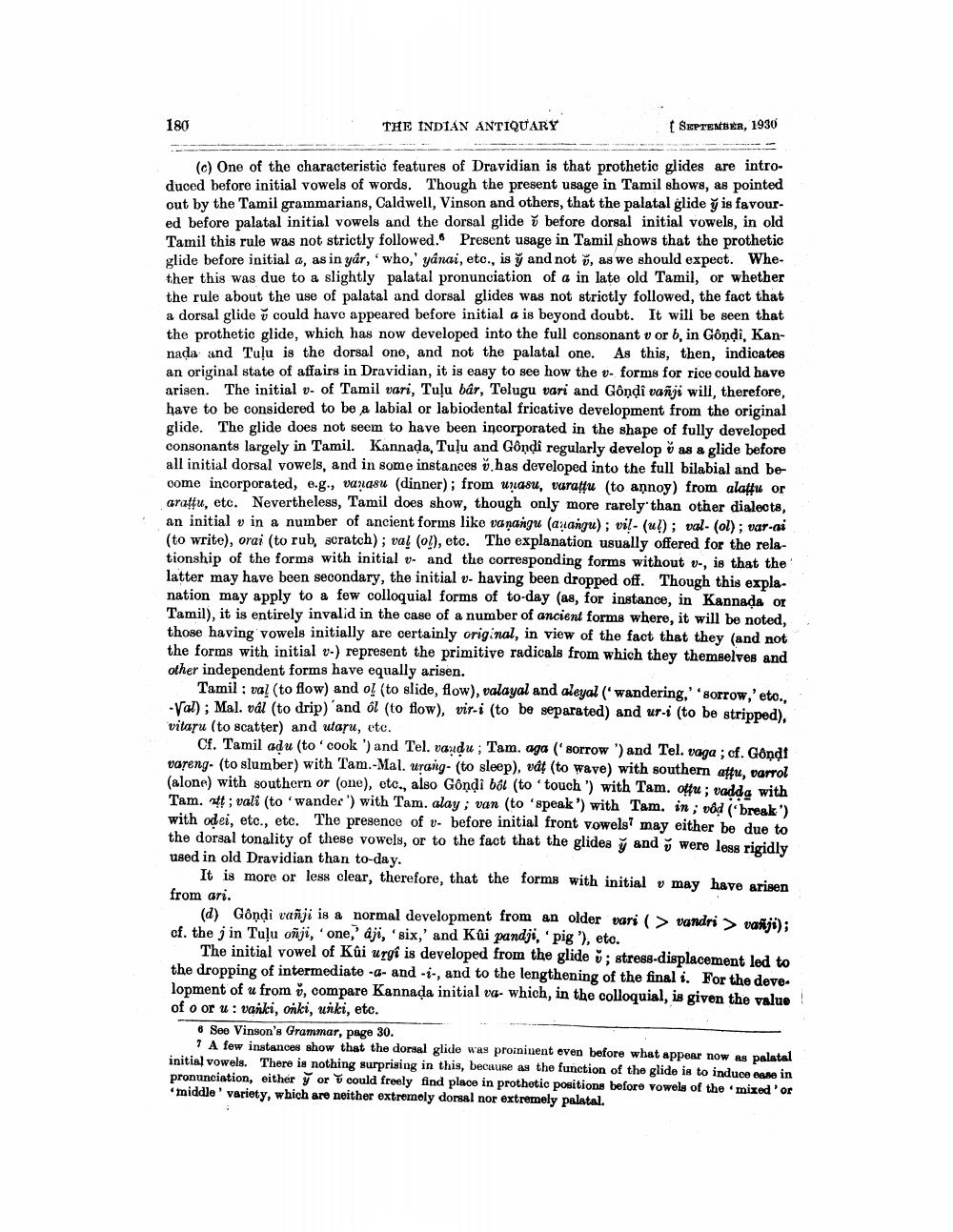________________
180
THE INDIAN ANTIQUARY
[ SEPTEMBER, 1930
(c) One of the characteristic features of Dravidian is that prothetic glides are introduced before initial vowels of words. Though the present usage in Tamil shows, as pointed out by the Tamil grammarians, Caldwell, Vinson and others, that the palatal glide vis favoured before palatal initial vowels and the dorsal glide 7 before dorsal initial vowels, in old Tamil this rule was not strictly followed. Present usage in Tamil shows that the prothetic glide before initial a, as in yâr, who,' yanai, etc., is y and not 7, as we should expect. Whether this was due to a slightly palatal pronunciation of a in late old Tamil, or whether the rule about the use of palatal and dorsal glides was not strictly followed, the fact that a dorsal glide could have appeared before initial a is beyond doubt. It will be seen that the prothetic glide, which has now developed into the full consonant v or b, in Gôndi, Kannada and Tulu is the dorsal one, and not the palatal one. As this, then, indicates an original state of affairs in Dravidian, it is easy to see how the v- forms for rice could have arisen. The initial v- of Tamil vari, Tuļu bár, Telugu vari and Gôndi vanji will, therefore, have to be considered to be a labial or labiodental fricative development from the original glide. The glide does not seem to have been incorporated in the shape of fully developed consonants largely in Tamil. Kannada, Tuļu and Gôndi regularly develop as a glide before all initial dorsal vowels, and in some instances y has developed into the full bilabial and become incorporated, e.g., vanasu (dinner); from unasu, vuratu (to annoy) from alattu or arattu, etc. Nevertheless, Tamil does show, though only more rarely than other dialects, an initial v in a number of ancient forms like vanangu (anangu); vil - (ul); val. (ol); var-ai (to write), orai (to rub, scratch); val (ol), etc. The explanation usually offered for the relationship of the forms with initial v- and the corresponding forms without v-, is that the latter may have been secondary, the initial v-having been dropped off. Though this explanation may apply to a few colloquial forms of to-day (as, for instance, in Kannada or Tamil), it is entirely invalid in the case of a number of ancient forms where, it will be noted, those having vowels initially are certainly original, in view of the fact that they (and not the forms with initial v-) represent the primitive radicals from which they themselves and other independent forms have equally arisen.
Tamil: val (to flow) and o! (to slide, flow), valayal and aleyal ('wandering.' sorrow,' eto... -Val); Mal. vál (to drip)'and ôl (to flow), vir-i (to be separated) and ur-i (to be stripped), vitasu (to scatter) and utaru, etc.
Cf. Tamil adu (to cook ') and Tel. vandu; Tam, aga 'sorrow ') and Tel. vaga ; cf. Gôndt vareng. (to slumber) with Tam.-Mal. urang- (to sleep), våt (to wave) with southern attu, varrol (alone) with southern or (one), etc., also Gôndi ból (to 'touch ') with Tam. offu; vadda with Tam. at; vali (to 'wander ') with Tam. alay; van (to 'speak') with Tam, in; vôd (break") with odei, etc., etc. The presence of v- before initial front vowels? may either be due to the dorsal tonality of these vowels, or to the fact that the glidea y and ✓ were less rigidly used in old Dravidian than to-day.
It is more or less clear, therefore, that the forms with initial v may have arisen from ari.
(d) Gôndi vañji is a normal development from an older vars (> vandri > vafiji); cf. the j in Tuļu oñji, 'one,' aji, 'six,' and Kûi pandji, 'pig '), etc.
The initial vowel of Kûi urgi is developed from the glide ü; stress-displacement led to the dropping of intermediate -- and -;-, and to the lengthening of the final i. For the deve. lopment of u from , compare Kannada initial va- which, in the colloquial, is given the value of oor u: vanki, onki, unki, etc.
6 See Vinson's Grammar, page 30.
7 A few instances show that the dorsal glide was proininent even before what appear now as palatal initial vowels. There is nothing surprising in this, because as the function of the glide is to induce cose in pronunciation, either y or could freely find place in prothetic positions before vowels of the mized or middle' variety, which are neither extremely dorsal nor extremely palatal.




